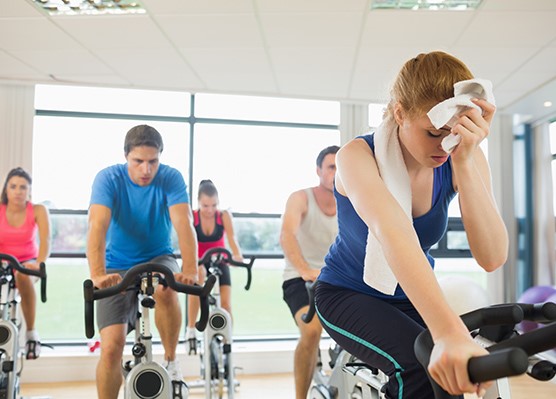 Hot yoga, hot indoor cycling and hot sculpting classes are the latest trend in the fitness industry. Proponents of these routines claim that you’ll burn more calories, lose more weight and have a better workout.
Hot yoga, hot indoor cycling and hot sculpting classes are the latest trend in the fitness industry. Proponents of these routines claim that you’ll burn more calories, lose more weight and have a better workout.
Here are the are two biggest risks of heated workouts:
Risk 1: Dehydration and/or hyperthermia can lead to minor heat cramps all the way to a fatal heat stroke. When you perspire you lose body fluids, and if they aren’t replaced it makes it difficult to continue sweating to lower your body temperature, which could lead to a heat injury.
Remember, when you exercise, 70 to 90 percent of your energy output is released by heat. You must not hinder the release of this heat; otherwise you can suffer a heat injury, which can be fatal.
Solutions:
1. Hydrate before, during and after workouts. Proper hydration depends on the individual, but the general rule of thumb is you should drink no less than 500 milliliters (0.5 liters) two hours prior to workout.
During your workout you should drink enough to replace fluid loss — about 700 to 1,000 milliliters of fluid. You know you were well hydrated during your workout if you haven’t dropped more than 2 percent of your total body weight after you’re done. Another good sign of proper hydration during training is to have clear, dilute urine afterward.
2. Consult your doctor. Make sure that any medications you’re taking are not dehydrating and won’t interfere with sweating.
3. Avoid caffeine and any heart-stimulating substances, including alcohol. These liquids have a diuretic effect, which can increase your risk of dehydration.
4. Adjust slowly. Go at your own pace to start and work your way up. Your body can adapt to higher temperatures, but it can take more than a week for this adaptation to occur. Take frequent breaks when necessary.
5. Wear light clothing for improved cooling.
Risk 2: Increased risk of injuries. Your muscles become more extensible when they are heated. California-based orthopedic surgeon Bal M. Rajagopalan, M.D, FRCSC, says, “Without knowing your end point of an exercise, you might strain ligaments, tendons and even connective tissue if you overload them beyond their normal capacity.”
Solution: Move your body within its normal range of motion when you are not training in the heat. Move slowly and mindfully and focus on breathing deeply to keep yourself connected to your movement patterns and avoid overstretching.
Most fitness experts will tell you not to exert yourself in the heat, but if you choose to do so, it’s important to exercise with caution.
Consider avoiding hot exercise environments if any of the following pertain to you:
* You are elderly.
* You have a chronic illness and are taking certain medication.
* You are severely obese.
* You have low cardiac reserve. (This means your heart is unable to adjust quickly to the changes the body goes through in extreme heat, such as an increased heart rate.)
Heart-failure patients and children younger than 4 years old usually have low cardiac reserves. They can become dehydrated very easily, even just by sitting in a house that is too hot or walking outside in hot weather.